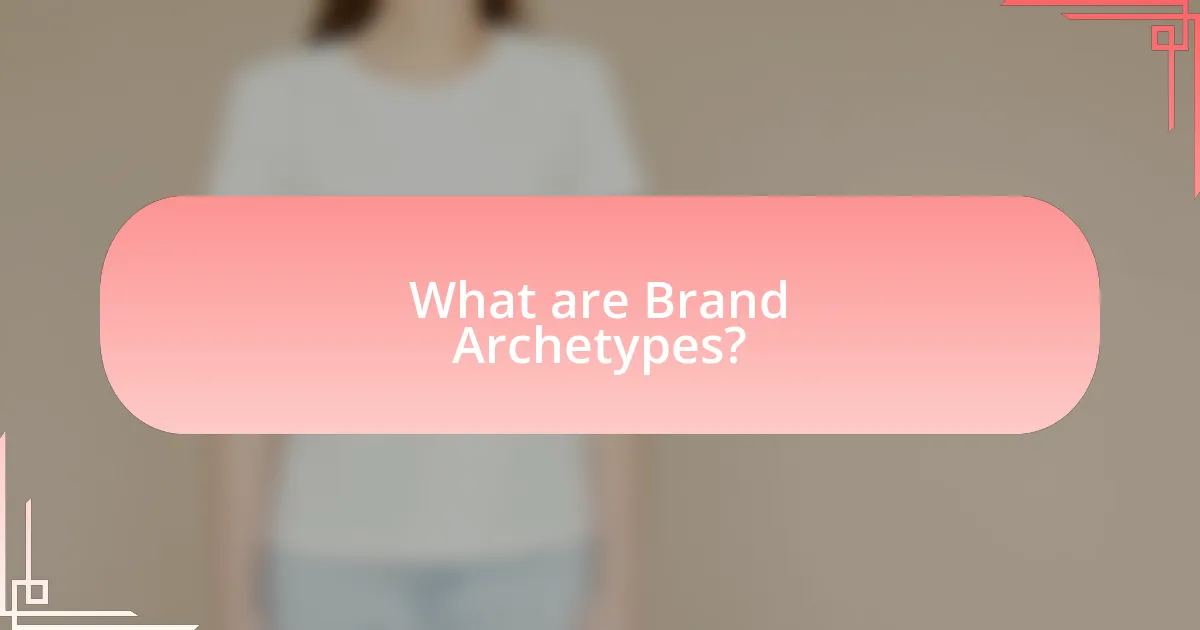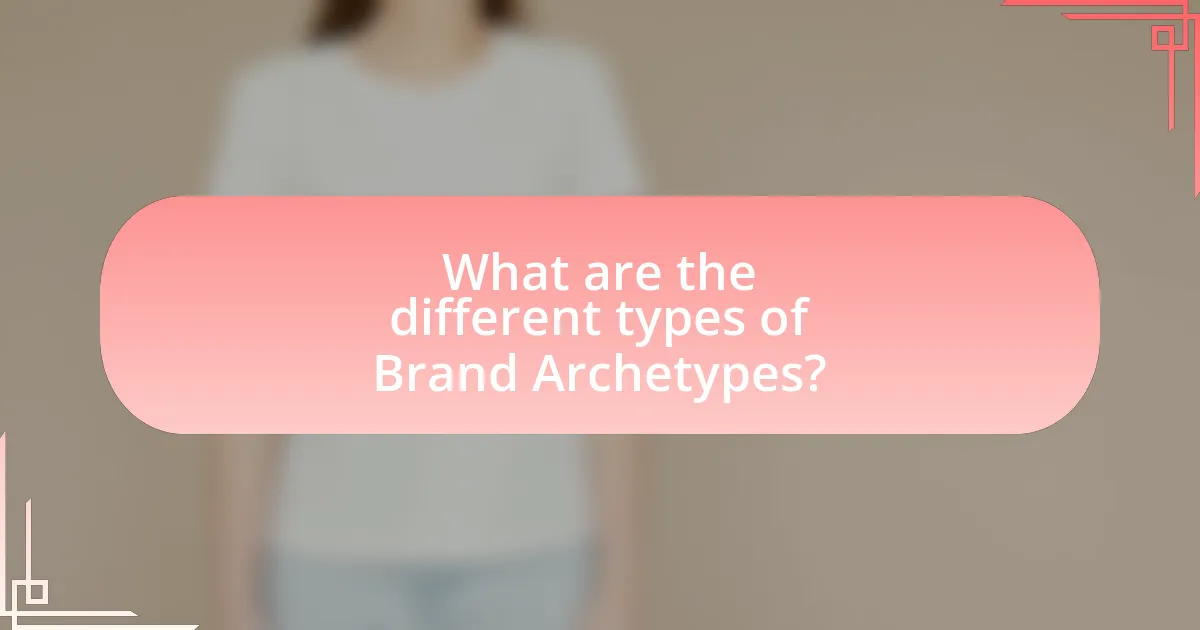Brand archetypes are universal symbols that represent specific human motivations and behaviors, playing a crucial role in branding by fostering emotional connections with consumers. Derived from Carl Jung’s psychological theories, these archetypes categorize brands into distinct personas, such as the Hero, Caregiver, and Rebel, which influence consumer perception and loyalty. The article explores how brand archetypes enhance brand identity, create emotional connections, and drive consumer engagement, while also detailing the twelve primary archetypes and their characteristics. Additionally, it discusses the importance of aligning brand messaging with chosen archetypes and the role of consumer feedback in refining these strategies for effective marketing.

What are Brand Archetypes?
Brand archetypes are universal symbols or character types that represent specific human motivations and behaviors, used in branding to create emotional connections with consumers. These archetypes, derived from Carl Jung’s psychological theories, categorize brands into distinct personas, such as the Hero, the Caregiver, or the Rebel, allowing companies to communicate their values and resonate with target audiences effectively. Research indicates that brands aligning with archetypes can enhance customer loyalty and engagement, as they tap into shared cultural narratives and emotional triggers, making the brand more relatable and memorable.
How do Brand Archetypes influence consumer perception?
Brand archetypes significantly influence consumer perception by creating emotional connections and establishing brand identity. These archetypes, such as the Hero, the Caregiver, or the Rebel, resonate with consumers’ values and aspirations, guiding their purchasing decisions. For instance, a brand embodying the Hero archetype may appeal to consumers seeking empowerment and achievement, while a Caregiver archetype may attract those valuing compassion and support. Research indicates that brands aligning with specific archetypes can enhance customer loyalty and trust, as consumers often prefer brands that reflect their self-image or ideals. This alignment fosters a sense of belonging and authenticity, ultimately shaping how consumers perceive and engage with the brand.
What psychological principles underpin Brand Archetypes?
Brand archetypes are underpinned by psychological principles such as Carl Jung’s theory of archetypes, which posits that universal symbols and themes resonate with human experiences and emotions. This theory suggests that brands can evoke specific feelings and associations by aligning with these archetypes, such as the Hero, the Caregiver, or the Rebel. Research indicates that consumers are more likely to connect with brands that reflect their own identities or aspirations, enhancing brand loyalty and engagement. For instance, a study published in the Journal of Brand Management found that brands embodying archetypes that resonate with consumers’ self-concepts lead to stronger emotional connections and purchasing intentions.
How do Brand Archetypes create emotional connections with consumers?
Brand archetypes create emotional connections with consumers by embodying universal human experiences and traits that resonate deeply with individuals. These archetypes, such as the Hero, the Caregiver, or the Rebel, tap into shared cultural narratives and psychological patterns, allowing consumers to identify with the brand on a personal level. For instance, brands like Nike, which aligns with the Hero archetype, inspire consumers through messages of perseverance and achievement, fostering a sense of empowerment and motivation. Research indicates that brands utilizing archetypes can enhance consumer loyalty and engagement, as they evoke emotions and values that consumers find relatable and meaningful. This emotional resonance is crucial, as it drives purchasing decisions and brand advocacy, ultimately leading to stronger brand-consumer relationships.
Why are Brand Archetypes important in marketing?
Brand archetypes are important in marketing because they help create a relatable and consistent brand identity that resonates with consumers. By aligning a brand with a specific archetype, marketers can tap into universal human emotions and motivations, making the brand more memorable and engaging. For instance, brands like Nike embody the Hero archetype, inspiring consumers through messages of courage and achievement, which can lead to increased brand loyalty and customer engagement. Research indicates that brands that effectively utilize archetypes can enhance their storytelling, making their marketing efforts more impactful and driving consumer connection.
What role do Brand Archetypes play in brand identity?
Brand archetypes play a crucial role in shaping brand identity by providing a framework that helps brands communicate their values, personality, and purpose. These archetypes, derived from Carl Jung’s psychological theories, categorize brands into universal characters, such as the Hero, the Caregiver, or the Rebel, which resonate with consumers on an emotional level. By aligning with a specific archetype, brands can create a consistent narrative and foster deeper connections with their target audience. For instance, brands like Nike embody the Hero archetype, inspiring customers through themes of perseverance and achievement. This alignment not only enhances brand recognition but also influences consumer perception and loyalty, as evidenced by studies showing that brands with clear archetypal identities are more likely to engage and retain customers.
How can Brand Archetypes enhance brand loyalty?
Brand archetypes enhance brand loyalty by creating a strong emotional connection between the brand and its consumers. When brands align with specific archetypes, such as the Hero or the Caregiver, they resonate with consumers’ values and aspirations, fostering a sense of belonging and trust. Research indicates that brands embodying clear archetypes can increase customer retention rates by up to 30%, as consumers are more likely to remain loyal to brands that reflect their identity and beliefs. This alignment not only drives repeat purchases but also encourages word-of-mouth referrals, further solidifying brand loyalty.

What are the different types of Brand Archetypes?
There are twelve primary types of brand archetypes, which are categorized based on their core motivations and characteristics. These archetypes include the Innocent, Explorer, Sage, Hero, Outlaw, Magician, Regular Guy/Gal, Lover, Caregiver, Creator, Ruler, and Jester. Each archetype represents a distinct personality and approach to branding, influencing how brands connect with their audience and convey their values. For instance, the Hero archetype embodies courage and determination, while the Caregiver archetype focuses on compassion and support. Understanding these archetypes helps brands to create a more authentic and relatable identity in the marketplace.
How can we categorize Brand Archetypes?
Brand archetypes can be categorized into twelve distinct types based on their core motivations and characteristics. These archetypes include the Innocent, Explorer, Sage, Hero, Outlaw, Magician, Regular Guy/Gal, Lover, Caregiver, Creator, Ruler, and Jester. Each archetype represents a specific set of values and emotional triggers that resonate with consumers, influencing their perceptions and relationships with brands. For example, the Hero archetype embodies courage and determination, appealing to consumers’ desires for achievement and inspiration. This categorization is rooted in Carl Jung’s psychological theories, which suggest that archetypes are universal symbols that shape human behavior and storytelling.
What are the primary characteristics of each Brand Archetype?
The primary characteristics of each Brand Archetype include the following:
- The Innocent: Values simplicity and optimism, aiming to do things right and promote happiness.
- The Explorer: Seeks freedom and adventure, encouraging discovery and self-exploration.
- The Sage: Pursues knowledge and truth, providing wisdom and insight to others.
- The Hero: Embodies courage and determination, striving to improve the world through strength and resilience.
- The Outlaw: Challenges the status quo, promoting revolution and change through nonconformity.
- The Magician: Transforms ideas into reality, inspiring innovation and creativity.
- The Regular Guy/Gal: Relates to the everyday person, emphasizing authenticity and belonging.
- The Lover: Celebrates passion and intimacy, focusing on connection and emotional experiences.
- The Caregiver: Prioritizes nurturing and support, aiming to protect and care for others.
- The Ruler: Exudes control and order, seeking to create stability and leadership.
- The Jester: Embraces humor and playfulness, encouraging joy and light-heartedness.
- The Creator: Values originality and self-expression, striving to bring new ideas to life.
These archetypes are rooted in psychological theories, such as Carl Jung’s archetypes, which suggest that these universal symbols resonate with human experiences and emotions, making them effective in branding.
How do different industries utilize various Brand Archetypes?
Different industries utilize various Brand Archetypes to connect with their target audiences and convey specific values. For instance, the Hero archetype is prevalent in the sports industry, where brands like Nike inspire consumers through messages of perseverance and achievement. In contrast, the Caregiver archetype is commonly found in healthcare, with organizations like Johnson & Johnson emphasizing compassion and support. The Rebel archetype is often used in the fashion industry, as seen with brands like Diesel, which challenge norms and appeal to individuality. These archetypes help brands create emotional connections, enhance brand loyalty, and differentiate themselves in competitive markets.
What are some examples of successful Brand Archetypes?
Successful brand archetypes include the Hero, the Caregiver, and the Rebel. The Hero archetype is exemplified by brands like Nike, which inspires consumers to overcome challenges and achieve greatness through its “Just Do It” campaign. The Caregiver archetype is represented by brands such as Johnson & Johnson, which emphasizes compassion and care in its messaging, focusing on health and well-being. The Rebel archetype is embodied by brands like Harley-Davidson, which promotes freedom and nonconformity, appealing to consumers’ desire for individuality and adventure. These examples demonstrate how brands effectively leverage archetypes to connect emotionally with their target audiences.
How do these examples illustrate the effectiveness of Brand Archetypes?
Brand archetypes effectively resonate with consumers by tapping into universal human emotions and narratives, as illustrated by examples like Nike’s “Hero” archetype and Apple’s “Creator” archetype. Nike’s campaigns, such as “Just Do It,” motivate individuals to overcome challenges, fostering a strong emotional connection that drives brand loyalty. Similarly, Apple’s focus on innovation and creativity aligns with the “Creator” archetype, appealing to consumers’ desires for self-expression and uniqueness. These examples demonstrate that brands leveraging archetypes can create compelling narratives that enhance consumer engagement and loyalty, supported by research indicating that emotional branding significantly influences purchasing decisions.
What lessons can be learned from these successful brands?
Successful brands demonstrate the importance of aligning their identity with consumer values and emotions. For instance, brands like Apple and Nike effectively utilize the “Hero” archetype, inspiring customers through innovation and empowerment. This alignment fosters strong emotional connections, leading to brand loyalty and advocacy. Research indicates that emotionally connected customers are more than twice as valuable as highly satisfied customers, highlighting the effectiveness of this strategy. Additionally, successful brands often emphasize consistency in messaging and experience, reinforcing their identity and building trust over time.

How can brands effectively implement Archetypes?
Brands can effectively implement archetypes by clearly defining their core identity and aligning their messaging, visuals, and customer interactions with that archetype. For instance, a brand embodying the Hero archetype should focus on themes of courage and achievement in its marketing campaigns, showcasing stories of overcoming challenges. Research indicates that brands that consistently align with their chosen archetype can enhance customer loyalty and emotional connection; for example, Nike’s use of the Hero archetype has contributed to its strong brand identity and market position. By maintaining this alignment across all touchpoints, brands can create a cohesive narrative that resonates with their target audience.
What steps should brands take to identify their Archetype?
Brands should conduct a thorough analysis of their values, mission, and target audience to identify their Archetype. This involves defining core brand attributes and understanding customer perceptions through surveys or focus groups. Additionally, brands can utilize established frameworks, such as Carl Jung’s archetypes, to categorize their identity. Research indicates that aligning brand messaging with a specific archetype enhances customer loyalty and engagement, as seen in studies by the American Marketing Association, which highlight the effectiveness of archetypal branding in resonating with consumers.
How can brands align their messaging with their chosen Archetype?
Brands can align their messaging with their chosen Archetype by ensuring that their communication reflects the core values, traits, and narratives associated with that Archetype. For instance, a brand embodying the Hero Archetype should focus on themes of courage, achievement, and overcoming challenges in its messaging. This alignment can be validated by examining successful brands like Nike, which consistently communicates a message of perseverance and triumph, resonating with the Hero’s ethos. By integrating these characteristics into advertising, social media, and customer interactions, brands can create a cohesive identity that strengthens their connection with their target audience.
What tools can brands use to assess their Archetype alignment?
Brands can use tools such as archetype assessment questionnaires, brand personality frameworks, and customer feedback surveys to assess their Archetype alignment. Archetype assessment questionnaires, like the one developed by Carol S. Pearson, help brands identify their core archetype by evaluating their values, mission, and messaging. Brand personality frameworks, such as the Aaker Model, provide a structured approach to understanding how brand traits align with specific archetypes. Customer feedback surveys can reveal how consumers perceive a brand’s identity and whether it resonates with the intended archetype, thus providing actionable insights for alignment.
What common pitfalls should brands avoid when using Archetypes?
Brands should avoid oversimplifying archetypes, as this can lead to a lack of authenticity and depth in their messaging. When brands reduce complex human experiences to basic archetypes, they risk alienating their audience and failing to resonate on a meaningful level. For instance, a brand that solely identifies as a “Hero” may overlook the nuances of its identity, leading to a one-dimensional portrayal that does not reflect the diverse values of its customer base. Additionally, brands should be cautious of inconsistent application of archetypes across different platforms, as this can create confusion and dilute brand identity. Research indicates that consistent brand messaging enhances customer trust and loyalty, making it crucial for brands to align their archetype representation with their overall narrative.
How can brands ensure authenticity in their Archetype representation?
Brands can ensure authenticity in their Archetype representation by aligning their messaging, values, and actions with the core characteristics of the chosen Archetype. This alignment requires a deep understanding of the Archetype’s traits and the brand’s mission, ensuring that every aspect of the brand experience reflects these elements. For instance, a brand embodying the Hero Archetype should consistently demonstrate courage and resilience in its marketing and customer interactions. Research indicates that brands that authentically represent their Archetypes can enhance customer loyalty and trust, as consumers are more likely to connect with brands that resonate with their values and beliefs.
What strategies can mitigate the risks of misalignment with Archetypes?
To mitigate the risks of misalignment with Archetypes, brands should conduct thorough market research to understand their target audience’s perceptions and expectations. This research enables brands to align their messaging and identity with the appropriate Archetype that resonates with consumers. Additionally, brands can implement regular feedback mechanisms, such as surveys and focus groups, to gauge audience reactions and adjust their strategies accordingly. For instance, companies like Apple have successfully maintained alignment with the “Innovator” Archetype by consistently innovating and seeking consumer input, which reinforces their brand identity and mitigates misalignment risks.
What are best practices for leveraging Brand Archetypes in marketing?
Best practices for leveraging Brand Archetypes in marketing include clearly identifying the archetype that aligns with the brand’s core values and target audience. This alignment ensures that marketing messages resonate emotionally with consumers, as archetypes tap into universal human experiences. For instance, brands like Nike embody the Hero archetype, inspiring customers through stories of perseverance and achievement. Additionally, consistent application of the chosen archetype across all marketing channels—such as social media, advertising, and customer interactions—reinforces brand identity and builds trust. Research indicates that brands that effectively utilize archetypes can enhance customer loyalty and engagement, as they create a deeper connection with their audience by reflecting shared values and aspirations.
How can storytelling enhance the effectiveness of Brand Archetypes?
Storytelling enhances the effectiveness of Brand Archetypes by creating emotional connections that resonate with consumers. When brands utilize storytelling, they can embody archetypes such as the Hero or the Caregiver, allowing consumers to identify with the brand’s narrative and values. This identification fosters loyalty and trust, as consumers feel understood and represented. Research indicates that narratives can increase engagement by up to 300%, demonstrating that well-crafted stories can significantly amplify the impact of brand archetypes on consumer perception and behavior.
What role does consumer feedback play in refining Brand Archetype strategies?
Consumer feedback is crucial in refining Brand Archetype strategies as it provides insights into how consumers perceive and connect with a brand’s identity. This feedback allows brands to adjust their messaging, tone, and overall strategy to align more closely with consumer expectations and emotional responses. For instance, a study by the Harvard Business Review found that brands that actively incorporate consumer feedback into their strategies see a 20% increase in customer loyalty. By analyzing feedback, brands can identify which archetypes resonate most effectively with their target audience, leading to more tailored and impactful marketing efforts.


